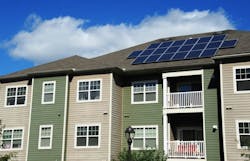How to Finance Multifamily Solar Projects
On-site solar installations have steadily dropped in price over the last few years, leading to greater adoption by commercial buildings and residences. But multifamily buildings seem to lag behind when it comes to solar installations.
One reason is the barrier created by the “split incentive.” In other words, building owners and managers take on all the costs and risks of installing solar panels, but the tenants reap most of the profits because each housing unit pays for its own electricity consumption, leaving the owner no savings to pay back the investment.
“The technologies to bring multifamily buildings more off grid and reduce building energy costs require significant upfront investments from the owners of multifamily buildings,” says Rebecca Arnold, vice president of Lever Energy Capital, a financing provider for commercial energy projects. “It’s hard for an owner to rationalize making such large upfront investments in technologies that reduce grid dependence and energy costs when the owner is not receiving much financial benefit from those investments.”
However, owners of multifamily properties aren’t out of options when it comes to reducing grid dependence. Innovative financing strategies can help offset the split incentive problem by creating an avenue for the owner to pay down loans or agreements gradually, while still delivering energy savings for both the owner and the tenants.
How to Finance Multifamily Solar Projects
There are several financing strategies available for multifamily properties. Your four options include:
1. Commercial Property Assessed Clean Energy (C-PACE)
C-PACE financing is a type of loan that finances the entire cost of a property owner’s investment in energy efficiency, renewable energy, water conservation or hazard mitigation projects. The owner doesn’t have to put up a large, upfront capital investment. The financing is assessed as a property tax “in exchange for low-rate, long-term, non-recourse and fully transferable financing on the property,” Arnold explains.
“Generally speaking, solar panels will eliminate a significant amount of property utility costs on an annual basis,” Arnold adds. “We often see the annual utility savings resulting from solar panels being enough to cover the annual C-PACE financing amount for those solar panels. Essentially, you are structuring the solar panels to pay for themselves over time by using C-PACE financing.”
2. Energy Efficiency and Renewable Energy Loans
These loans are typically offered by credit unions or banks, according to the Center for Sustainable Energy, a nonprofit specializing in energy program administration and advising. The loans are secured and typically have low interest rates.
3. Lease or Power Purchase Agreements
Both of these options involve a third party who owns the solar power system. You pay the owner every month. In a lease, you pay a fixed monthly rate regardless of how much power your panels produce, the Center for Sustainable Energy explains. Ideally, your lease payment is smaller than your original electric bill.
BUILDINGS Podcast
The Future of Solar Power
Solar panels look much like they always have, but their consistent appearance belies big improvements in efficiency and affordability. Listen now >>
A power purchase agreement (PPA) requires you to pay a fixed amount for each kWh produced by the system, just like you do to your utility for common areas and other areas of the building that aren’t part of tenant spaces. The price stipulated by the PPA is less than what your utility charges. Both typically involve 20-year contracts, the Center for Sustainable Energy explains.
The installation will also increase the property’s value by up to $650,000, Lever estimates. Tenants will notice a slight reduction in their energy bills.
4. Multifamily Solar Tax Credit
The federal government offers a one-time tax credit for installing solar PV systems on multifamily properties, the Center for Sustainable Energy says. Offsetting part of the cost with a tax credit will reduce the amount you have to borrow, so it’s worth investigating.
However, the value of the multifamily solar tax credit is beginning to decline, so it’s crucial to get started now. Projects placed in service before Dec. 31, 2019, can benefit from a tax credit of 30% of the total system cost; starting in 2020, the value drops to 26%, then 22% for 2021 and 10% for projects placed in service after Jan. 1, 2022.
These financing strategies won’t solve the split incentive problem completely, but they can make solar investments much more financially attractive. Know your options so you can reap the most benefits possible from on-site solar power.
Read more about solar energy:
About the Author
Janelle Penny
Editor-in-Chief at BUILDINGS
Janelle Penny has been with BUILDINGS since 2010. She is a two-time FOLIO: Eddie award winner who aims to deliver practical, actionable content for building owners and facilities professionals.

